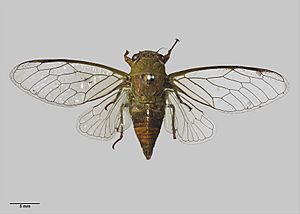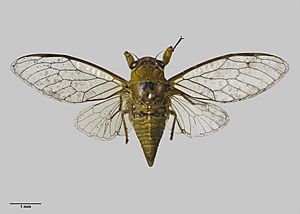Kikihia ochrina facts for kids
Quick facts for kids Kikihia ochrina |
|
|---|---|
 |
|
| Female syntype specimen | |
 |
|
| Male syntype specimen | |
| Scientific classification | |
| Genus: |
Kikihia
|
| Species: |
ochrina
|
| Synonyms | |
|
|
Kikihia ochrina (often called the April green cicada) is a special insect found only in New Zealand. This cicada has a life cycle that lasts about three years. Adult cicadas are bright green. You can usually see them in April, especially in the North Island.
Contents
About the April Green Cicada
How it Got its Name
A British bug expert named Francis Walker first described this cicada. He did this in 1858. He called it Cicada ochrina. He studied a specimen given to the Natural History Museum, London.
Later, in 1891, another expert, George Hudson, thought it was a new species. He named it Cicada aprilina. This name came from the month of April, when these cicadas are often seen.
What it Looks Like
The Kikihia ochrina cicada is bright green. It has only a few dark marks on its body. The most noticeable marks are two curved lines and two dots. These are found on the middle part of its body, called the thorax.
You can tell this cicada apart from its close relative, Kikihia dugdalei. The April green cicada has green legs. K. dugdalei has pink patches on its legs. Also, male K. ochrina cicadas do not have small black spots on their underside. Most male K. dugdalei cicadas do have these spots.
The famous New Zealand bug expert, George Hudson, thought this was the most beautiful New Zealand cicada. He said its song was "very quick and shrill."
Its Life Cycle
April green cicadas appear every summer. The female cicadas likely lay their eggs from January to May. The most eggs are laid in March. These eggs then develop over the winter months.
The young cicadas, called nymphs, hatch in the summer. This probably happens around December. So, the eggs take about 7 to 11 months to grow. Once they hatch, the nymphs immediately dig underground. They stay there for two more years.
After two years, they come out of the ground. They shed their outer skin, called an exoskeleton. Then they change into an adult cicada. This species usually lives for about three years in total. George Hudson believed that adult cicadas first appear around February. But they are most common in April.
Where it Lives and Its Home
The Kikihia ochrina cicada is found in the North Island of New Zealand. It also lives on the Three Kings Islands. It was probably brought to the Canterbury area.
This cicada lives in evergreen trees and shrubs. It especially likes native broadleaf plants. These include Coprosma, Hebe, and Myoporum. It also lives in trees that were brought to New Zealand, like Poplars. It often comes out of the soil from under the mahoe tree.
How it Behaves and Stays Safe
George Hudson thought this cicada was very careful. If it was disturbed, it would fly away a long distance. He thought this extreme caution was because K. ochrina appears later in the year. This might mean it faces more birds trying to eat it. So, it learned to be extra careful.

